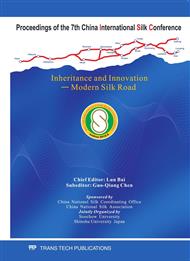p.837
p.843
p.849
p.853
p.859
p.865
p.873
p.879
p.884
Research on High Grade Sense of Silk Garment Based on Kansei Engineering
Abstract:
Silk was the most ancient export commodity, and it’s the evidence and pride of Chinese civilization. Silk is of noble temperament and deep culture; it is loved by old and young man at home and abroad. The high price of silk depends on its technic, therefore, in the development of silk garment, it is essential to consider high grade sense of silk garment. Silk has a certain high grade sense on texture and sheen, but it still needs to be combined with apparel color and pattern, which can make silk garment possess high grade sense. The paper aims at apparel color and pattern, extracts the key factors of high grade sense through the investigation of the comprehension and cognition of people. The paper is on the basis of the theory of Kansei Engineering. It extracts emotional evaluation factors of garment high grade sense by the way of interview and questionnaire survey, and then the author analyses the survey data by the statistic software of SPSS17.0. Finally the author concludes the different kinds of high grade sense which are understood by people. As a result, they can lead the development of silk garment.
Info:
Periodical:
Pages:
859-864
Citation:
Online since:
January 2011
Authors:
Price:
Сopyright:
© 2011 Trans Tech Publications Ltd. All Rights Reserved
Share:
Citation:


